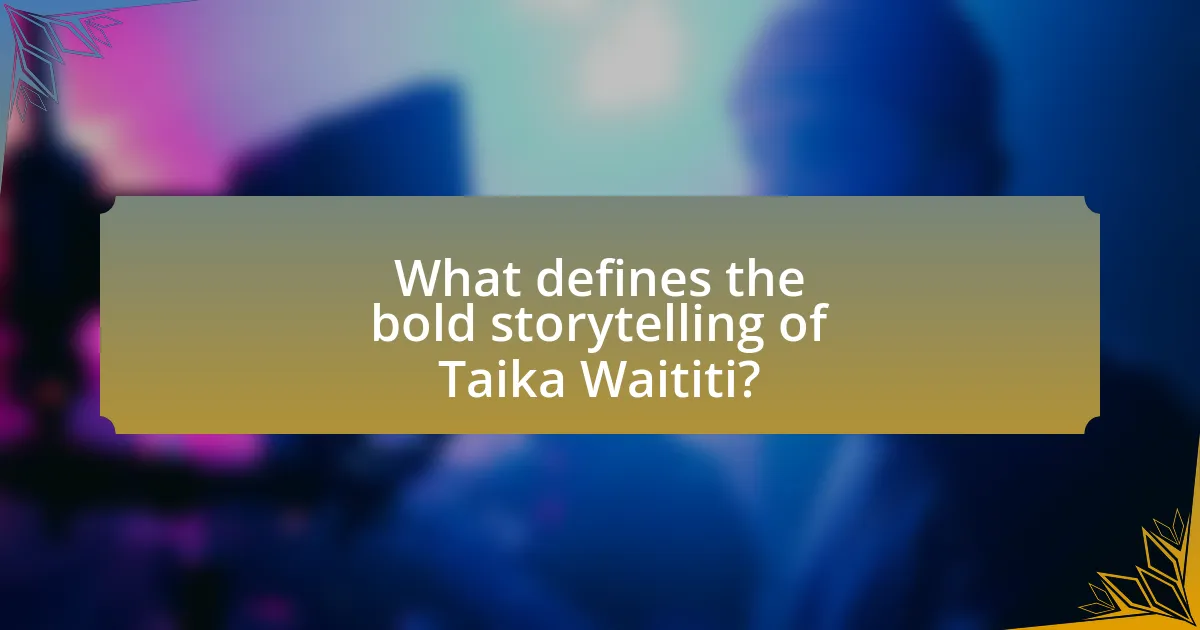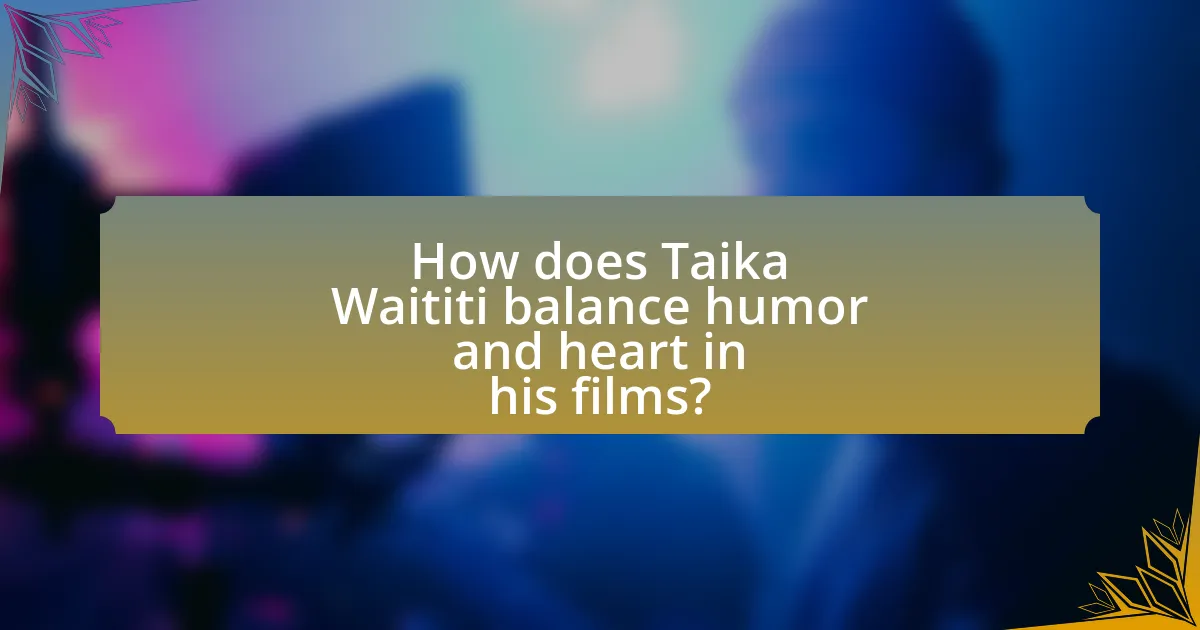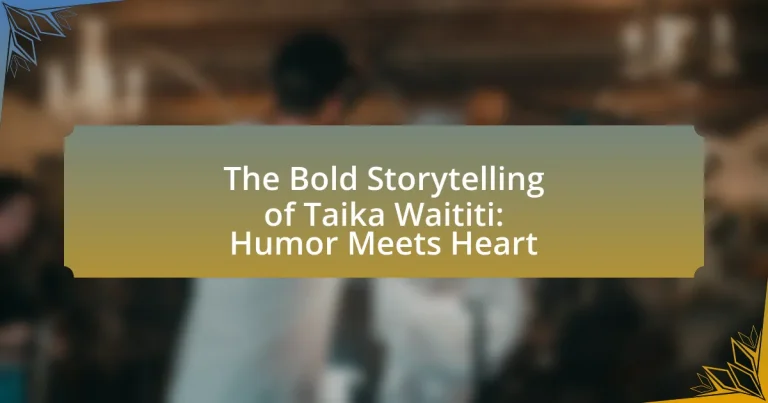The article examines the bold storytelling of Taika Waititi, highlighting his unique blend of humor and emotional depth in films such as “What We Do in the Shadows” and “Jojo Rabbit.” It explores how humor serves as a central element in his narratives, balancing serious themes like identity and belonging with comedic relief. Key comedic techniques, including absurdist humor and character-driven interactions, are discussed, along with the significance of family and cultural identity in his storytelling. The article also analyzes how Waititi effectively shifts tones and maintains audience engagement, ultimately demonstrating the impact of his distinctive style on critical reception and viewer connection.

What defines the bold storytelling of Taika Waititi?
The bold storytelling of Taika Waititi is defined by its unique blend of humor and emotional depth. Waititi often employs absurdist comedy and whimsical narratives that challenge conventional storytelling, as seen in films like “What We Do in the Shadows” and “Jojo Rabbit.” His ability to tackle serious themes, such as identity and belonging, while maintaining a lighthearted tone exemplifies this approach. For instance, “Jojo Rabbit” juxtaposes the innocence of childhood with the horrors of war, showcasing how humor can coexist with poignant social commentary. This distinctive style has garnered critical acclaim and resonated with diverse audiences, reinforcing the effectiveness of his storytelling technique.
How does humor play a role in Taika Waititi’s films?
Humor is a central element in Taika Waititi’s films, serving to balance emotional depth with comedic relief. His unique style often blends absurdity with poignant moments, allowing audiences to engage with serious themes while still enjoying lightheartedness. For instance, in “What We Do in the Shadows,” the mockumentary format highlights the mundane aspects of vampire life, creating humor through relatable situations. Additionally, in “Jojo Rabbit,” humor is used to critique ideology and innocence, as the film juxtaposes a child’s perspective with the absurdity of war. This approach not only entertains but also provokes thought, demonstrating how humor can effectively convey complex messages.
What comedic techniques does Waititi employ to engage audiences?
Taika Waititi employs several comedic techniques to engage audiences, including absurdist humor, deadpan delivery, and cultural references. Absurdist humor is evident in his films like “What We Do in the Shadows,” where the ridiculousness of vampire life is juxtaposed with mundane human experiences, creating a unique comedic effect. Deadpan delivery, often used by characters in his films, enhances the humor by presenting outrageous situations in a serious manner, as seen in “Hunt for the Wilderpeople.” Additionally, Waititi incorporates cultural references and personal anecdotes, which resonate with audiences and add layers of relatability, exemplified in “Jojo Rabbit,” where humor is derived from the juxtaposition of childhood innocence against the backdrop of World War II. These techniques collectively create a distinctive comedic style that captivates viewers.
How does humor enhance the emotional depth of his narratives?
Humor enhances the emotional depth of Taika Waititi’s narratives by providing a contrast that amplifies the impact of serious themes. In his films, comedic elements often serve as a vehicle for exploring complex emotions, allowing audiences to engage with difficult subjects like loss, identity, and cultural conflict in a more accessible way. For instance, in “Hunt for the Wilderpeople,” the use of humor in the relationship between the characters Ricky and Hec lightens the narrative while simultaneously deepening the emotional resonance of their journey together. This interplay between humor and heartfelt moments creates a richer storytelling experience, as evidenced by the film’s critical acclaim and audience connection, demonstrating that laughter can coexist with profound emotional truths.
What themes are prevalent in Waititi’s storytelling?
Taika Waititi’s storytelling prominently features themes of identity, belonging, and the intersection of humor and tragedy. His works often explore the complexities of cultural identity, particularly through the lens of Māori heritage, as seen in films like “Hunt for the Wilderpeople” and “Moana.” Additionally, Waititi blends humor with poignant moments, illustrating how laughter can coexist with deeper emotional truths, a technique evident in “Jojo Rabbit,” where satire addresses serious themes of war and prejudice. This combination of lightheartedness and emotional depth allows audiences to engage with challenging subjects in a relatable manner.
How does Waititi address cultural identity in his films?
Taika Waititi addresses cultural identity in his films by integrating his Māori heritage into storytelling, which emphasizes the importance of cultural narratives and representation. For instance, in “Hunt for the Wilderpeople,” Waititi explores themes of belonging and identity through the lens of a young Māori boy, showcasing the significance of family and cultural roots. Additionally, in “Jojo Rabbit,” he juxtaposes the absurdity of Nazi ideology with a child’s innocent perspective, highlighting the complexities of identity in a multicultural context. This approach not only reflects his personal experiences but also resonates with broader themes of cultural diversity and acceptance, reinforcing the idea that identity is multifaceted and shaped by both personal and societal influences.
What role does family play in his storytelling approach?
Family plays a central role in Taika Waititi’s storytelling approach, often serving as a source of inspiration and thematic depth. His narratives frequently explore familial relationships, highlighting the complexities and humor inherent in them, as seen in films like “Hunt for the Wilderpeople” and “Jojo Rabbit.” In these works, Waititi draws from his own experiences and cultural background, infusing his stories with authenticity and emotional resonance that reflect the significance of family dynamics. This emphasis on family not only enriches his characters but also connects with audiences on a personal level, making his storytelling both relatable and impactful.

How does Taika Waititi balance humor and heart in his films?
Taika Waititi balances humor and heart in his films by intertwining comedic elements with deeply emotional narratives. His storytelling often features quirky characters and absurd situations that evoke laughter, while simultaneously addressing themes of love, loss, and identity. For instance, in “Hunt for the Wilderpeople,” the humor derived from the protagonist’s misadventures complements the poignant exploration of family and belonging, creating a rich emotional landscape. This blend is further exemplified in “Jojo Rabbit,” where satire and humor are used to tackle serious subjects like prejudice and war, ultimately delivering a heartfelt message about acceptance and understanding. Waititi’s unique ability to juxtapose lightheartedness with genuine emotional depth allows audiences to connect with his characters on multiple levels, making his films both entertaining and meaningful.
What are some examples of films that exemplify this balance?
Some examples of films that exemplify the balance of humor and heart in Taika Waititi’s storytelling are “Hunt for the Wilderpeople,” “What We Do in the Shadows,” and “Jojo Rabbit.” In “Hunt for the Wilderpeople,” the blend of comedic elements with themes of family and belonging showcases Waititi’s ability to evoke laughter while addressing deeper emotional issues. “What We Do in the Shadows” combines mockumentary humor with the exploration of friendship and identity among vampires, highlighting the absurdity of their existence. “Jojo Rabbit” uniquely juxtaposes comedy with the serious subject of World War II, using satire to convey messages about love and acceptance. Each film demonstrates Waititi’s skill in merging humor with poignant storytelling, making them prime examples of this balance.
How does “Jojo Rabbit” illustrate the blend of humor and serious themes?
“Jojo Rabbit” illustrates the blend of humor and serious themes by juxtaposing the innocence of childhood with the harsh realities of war and prejudice. The film employs satire and absurdity, particularly through the character of Jojo’s imaginary friend, Adolf Hitler, to highlight the ridiculousness of Nazi ideology. This comedic element serves to soften the impact of the film’s more serious messages about hate, acceptance, and the consequences of indoctrination. For instance, Jojo’s interactions with Elsa, a Jewish girl hiding in his home, transition from comedic misunderstandings to profound moments of empathy, showcasing how humor can coexist with and even enhance the exploration of deep emotional and moral dilemmas.
What techniques does Waititi use to shift tones effectively?
Taika Waititi employs several techniques to shift tones effectively, including juxtaposition, character-driven humor, and visual storytelling. Juxtaposition allows him to place contrasting elements side by side, creating a dynamic interplay between comedy and drama, as seen in films like “Hunt for the Wilderpeople,” where lighthearted moments coexist with serious themes of loss and belonging. Character-driven humor emerges from the unique personalities of his characters, making their comedic interactions feel authentic and relatable, which helps to balance heavier narrative elements. Additionally, Waititi utilizes visual storytelling techniques, such as color palettes and camera angles, to enhance emotional resonance, allowing audiences to feel the shift in tone without explicit dialogue. These methods collectively contribute to his distinctive narrative style, effectively blending humor with heartfelt moments.
Why is this balance significant for audiences?
The balance of humor and heart in Taika Waititi’s storytelling is significant for audiences because it creates an engaging emotional experience that resonates deeply. This duality allows viewers to connect with characters on a personal level, fostering empathy and understanding while also providing levity through humor. Research indicates that narratives combining humor and emotional depth can enhance audience retention and satisfaction, as seen in films like “Hunt for the Wilderpeople,” which received critical acclaim for its ability to blend these elements effectively. This balance not only entertains but also encourages reflection on serious themes, making the storytelling more impactful and memorable for audiences.
How does it affect audience engagement and emotional response?
Taika Waititi’s storytelling affects audience engagement and emotional response by blending humor with heartfelt moments, creating a unique narrative experience. This combination allows audiences to connect emotionally while also being entertained, leading to increased engagement. For instance, in films like “Hunt for the Wilderpeople,” the juxtaposition of comedic elements with themes of loss and belonging resonates deeply, resulting in a more profound emotional impact. Research indicates that humor can enhance emotional responses, making audiences more receptive to the underlying messages of a story, thus fostering a stronger connection to the characters and their journeys.
What impact does this balance have on critical reception?
The balance of humor and heart in Taika Waititi’s storytelling significantly enhances critical reception. Critics often praise this unique blend for its ability to engage audiences emotionally while providing comedic relief, making the narratives more relatable and impactful. For instance, films like “Hunt for the Wilderpeople” and “Jojo Rabbit” received acclaim for their deft combination of humor and poignant themes, leading to higher ratings on platforms like Rotten Tomatoes, where “Jojo Rabbit” holds a 93% approval rating. This critical appreciation stems from the effective way Waititi addresses serious subjects through a humorous lens, allowing for deeper discussions and reflections on complex issues, which resonates well with both audiences and critics alike.
What can we learn from Taika Waititi’s storytelling style?
Taika Waititi’s storytelling style teaches us the effective integration of humor and emotional depth. His films, such as “What We Do in the Shadows” and “Jojo Rabbit,” showcase how comedic elements can coexist with serious themes, allowing audiences to engage with complex issues in a relatable manner. This approach not only entertains but also fosters empathy, as seen in “Jojo Rabbit,” where humor is used to explore the impact of war and prejudice. By blending absurdity with heartfelt moments, Waititi demonstrates that storytelling can be both entertaining and thought-provoking, encouraging viewers to reflect on their own experiences and societal issues.
How can aspiring filmmakers apply Waititi’s techniques?
Aspiring filmmakers can apply Taika Waititi’s techniques by embracing a blend of humor and emotional depth in their storytelling. Waititi often uses absurdity and wit to tackle serious themes, allowing audiences to connect with characters on a deeper level while still enjoying the narrative. For instance, in films like “Hunt for the Wilderpeople,” he combines comedic elements with poignant moments, demonstrating that humor can coexist with heartfelt storytelling. This approach encourages filmmakers to explore the juxtaposition of light and dark themes, creating a more engaging and relatable experience for viewers.
What are key takeaways for blending humor with serious themes?
Blending humor with serious themes effectively requires a careful balance that enhances emotional resonance without undermining the gravity of the subject matter. Key takeaways include using humor as a tool for relief, which can make difficult topics more accessible; employing irony to highlight the absurdity of serious situations, thereby prompting reflection; and ensuring that comedic elements serve to deepen character development and audience connection rather than distract from the narrative. For instance, Taika Waititi’s films often juxtapose light-hearted moments with poignant themes, illustrating how humor can coexist with tragedy, ultimately enriching the storytelling experience.
How can character development enhance storytelling in a similar way?
Character development enhances storytelling by creating relatable and dynamic characters that drive emotional engagement. In narratives, well-developed characters undergo transformations that reflect their struggles, desires, and growth, which allows audiences to connect deeply with their journeys. For instance, in Taika Waititi’s films, characters often experience significant arcs that blend humor with poignant moments, illustrating how personal growth can resonate with viewers. This connection is supported by research indicating that audiences are more likely to engage with stories featuring complex characters, as they evoke empathy and investment in the narrative (Green & Brock, 2000). Thus, character development is essential for enriching storytelling by fostering emotional connections and enhancing the overall impact of the narrative.
What are best practices for creating emotionally resonant narratives?
Best practices for creating emotionally resonant narratives include developing relatable characters, utilizing conflict effectively, and incorporating universal themes. Relatable characters allow audiences to connect on a personal level, as seen in Taika Waititi’s films where characters often reflect real human experiences and emotions. Effective conflict drives the narrative forward and creates tension, which engages the audience; for instance, Waititi often juxtaposes humor with serious themes, enhancing emotional depth. Universal themes, such as love, loss, and identity, resonate across diverse audiences, making the narrative more impactful. These elements combined create a rich emotional landscape that captivates viewers and fosters a deeper connection to the story.
How can filmmakers ensure authenticity in their storytelling?
Filmmakers can ensure authenticity in their storytelling by deeply researching the cultural and social contexts of their narratives. This involves engaging with communities, consulting experts, and incorporating real-life experiences to create relatable and genuine characters. For instance, Taika Waititi often draws from his Māori heritage and personal experiences, which adds layers of authenticity to his films. By prioritizing accurate representation and understanding the nuances of the subjects they portray, filmmakers can create stories that resonate truthfully with audiences.
What strategies can be used to maintain audience engagement throughout a film?
To maintain audience engagement throughout a film, filmmakers can employ strategies such as strong character development, pacing, and humor. Strong character development ensures that viewers form emotional connections with the characters, making them invested in their journeys. Pacing keeps the narrative dynamic, balancing moments of tension with relief to sustain interest. Humor, particularly in the style of Taika Waititi, can provide levity and relatability, enhancing emotional resonance while keeping the audience entertained. These strategies are supported by research indicating that well-developed characters and effective pacing significantly enhance viewer retention and satisfaction in cinematic experiences.


